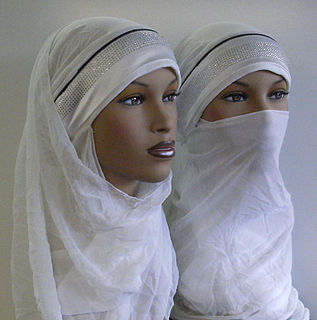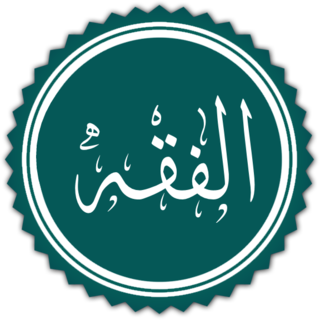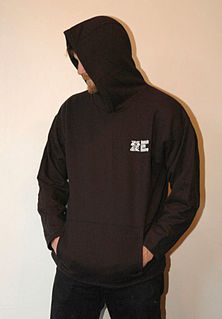
Punk fashion is the clothing, hairstyles, cosmetics, jewellery, and body modifications of the punk counterculture. Punk fashion varies widely, ranging from Vivienne Westwood designs to styles modeled on bands like The Exploited to the dressed-down look of North American hardcore. The distinct social dress of other subcultures and art movements, including glam rock, skinheads, rude boys, greasers, and mods have influenced punk fashion. Punk fashion has likewise influenced the styles of these groups, as well as those of popular culture. Many punks use clothing as a way of making a statement.

A balaclava, also known as a balaclava helmet or ski mask, is a form of cloth headgear designed to expose only part of the face, usually the eyes and mouth. Depending on style and how it is worn, only the eyes, mouth and nose, or just the front of the face are unprotected. Versions with enough of a full face opening may be rolled into a hat to cover the crown of the head or folded down as a collar around the neck.

A burqa or burka, also known as a chadaree in Afghanistan or a paranja in Central Asia, is an enveloping outer garment which covers the body and the face that is worn by women in some Islamic and Jewish traditions. The Arab version of the burqa is called the boshiya, and is usually black in color.

Indecent exposure is an expression that describes the deliberate public exposure by a person of a portion of their body in a manner contrary to local standards of appropriate behavior. Laws and social attitudes regarding indecent exposure vary significantly in different countries. It ranges from outright prohibition to prohibition of exposure of certain body parts, such as the genital area, buttocks or breasts.

Islamic clothing is clothing that is interpreted as being in accordance with the teachings of Islam. Muslims wear a wide variety of clothing, which is influenced not only by religious considerations, but also practical, cultural, social, and political factors. In modern times, some Muslims have adopted clothing based on Western traditions, while others wear modern forms of traditional Muslim dress, which over the centuries has typically included long, flowing garments. Besides its practical advantages in the climate of the Middle East, loose-fitting clothing is also generally regarded as conforming to Islamic teachings, which stipulate that body areas which are sexual in nature must be hidden from public view. Traditional dress for Muslim men has typically covered at least the head and the area between the waist and the knees, while traditional women's dress conceals the hair and the body from the ankles to the neck. Some Muslim women also cover their face. Islamic dress is influenced by two scriptural sources, the Quran and hadith. The Quran provides guiding principles believed to have come from God, while the body of hadith describes a human role model through the traditions of the Islamic prophet Muhammad. The branch of fashion industry influenced by Islamic principles is known as Islamic fashion.

A niqāb or niqaab, also called a ruband, is a garment that covers the face, worn by many Muslim women as a part of an interpretation of hijab. The terms niqab and burqa are often confused; a niqab covers the face while leaving the eyes uncovered, while a burqa covers the entire body from the top of the head to the ground, with only a mesh screen allowing the wearer to see in front of her. According to the majority of Muslim scholars and Islamic schools of thought, face veiling is not a requirement of Islam. Those Muslim women who wear the niqab, do so in places where they may encounter non-mahram (un-related) men.

A hoodie is a sweatshirt with a hood. Hoodies often include a muff sewn onto the lower front, and (usually) a drawstring to adjust the hood opening. It covers most of the head and neck and sometimes the face. Hoodies may be worn for protection against the environment

Lesbian, Gay, Bisexual and Transgender (LGBT) people in Afghanistan face legal challenges not experienced by non-LGBT residents. Members of the LGBT community are forced to keep their gender identity and sexual orientation a secret in fear of harassment, intimidation, persecution, and death. The religious nature of the nation has limited any opportunity for public discussion, with any mention of homosexuality and related terms deemed taboo.

A perp walk, walking the perp, or frog march, is a practice in American law enforcement of taking an arrested suspect through a public place, creating an opportunity for the media to take photographs and video of the event. The defendant is typically handcuffed or otherwise restrained, and is sometimes dressed in prison garb. Within the United States the perp walk is most closely associated with New York City. The practice rose in popularity in the 1980s under U.S. Attorney Rudolph Giuliani, when white-collar criminals were perp-walked.
Police uniforms and equipment in the United Kingdom have varied considerably from the inception of what were the earliest recognisable mainstream police services in the early 19th century. As various laws in the mid-19th century standardised policing in the United Kingdom, the uniforms and equipment become standardised. From a variety of home grown uniforms, bicycles, swords and pistols the British police force evolved in look and equipment through the long coats and top hat, to the recognisable modern uniform of a white shirt, black tie, reflective jackets, body armour, and the battenburg-marked vehicles, to the present-day Airwave Solutions radios, electric vehicles and tasers.
Hijab and burka controversies in Europe revolve around the variety of headdresses worn by Muslim women, which have become prominent symbols of the presence of Islam in especially Western Europe. In several countries, the adherence to hijab has led to political controversies and proposals for a legal partial or full ban in some or all circumstances. Some countries already have laws banning the wearing of masks in public, which can be applied to veils that conceal the face. Other countries are debating similar legislation, or have more limited prohibitions. Some of them apply only to face-covering clothing such as the burqa, boushiya, or niqab; some apply to any clothing with an Islamic religious symbolism such as the khimar, a type of headscarf. The issue has different names in different countries, and "the veil" or hijab may be used as general terms for the debate, representing more than just the veil itself, or the concept of modesty embodied in hijab.

A Baja jacket is a type of Mexican jacket with a single large pocket on the front, and vents on the side. They are more commonly made out of a coarse woolen fabric known as "jerga". They are often decorated with patterns consisting of horizontal stripes on the sleeves and hood, and vertical stripes down the rest of the jacket. The drawstrings are often flatter and more rectangular than most jacket drawstrings, and always made of the same material as the rest of the jacket.

The word hijab refers to both the head-covering traditionally worn by many Muslim women and to the concept of modesty in Islam generally. Afghanistan and Iran are the only countries where the hijab is compulsory.

James Patrick Bulger was a two-year-old boy from Kirkby, Merseyside, England, who was abducted, tortured, and murdered by two 10-year-old boys, Robert Thompson and Jon Venables, on 12 February 1993. Thompson and Venables led Bulger away from the New Strand Shopping Centre in Bootle as his mother had taken her eyes off him momentarily. His mutilated body was found on a railway line 2+1⁄2 miles away in Walton, Liverpool, two days after his abduction.

The French ban on face covering is an act of parliament passed by the Senate of France on 14 September 2010, resulting in the ban on the wearing of face-covering headgear, including masks, helmets, balaclavas, niqābs and other veils covering the face in public places, except under specified circumstances. This ban does not apply to the hijab, as it does not cover the face. The ban also applies to the burqa, a full-body covering, if it covers the face. Consequently, full body costumes and Zentais were banned. The bill had previously been passed by the National Assembly of France on 13 July 2010. In April 2011, France became the first European country to impose a ban on full-face veils in public areas.

Trayvon Benjamin Martin was a 17-year-old African-American boy from Miami Gardens, Florida, who was fatally shot in Sanford, Florida by George Zimmerman, a 28-year-old Hispanic American. Martin had accompanied his father to visit his father's fiancée at her townhouse at The Retreat at Twin Lakes in Sanford. On the evening of February 26, Martin was walking back to the fiancée's house from a nearby convenience store. Zimmerman, a member of the community watch, saw Martin and reported him to the Sanford Police as suspicious. Several minutes later, an altercation happened and Zimmerman fatally shot Martin in the chest.
Anti-mask or anti-masking laws are legislative or penal initiatives prohibiting the concealment of one's face in public. Anti-mask laws vary widely between jurisdictions in their intent, scope, and penalties.

In Australia, there is an ongoing debate over the possibility of a ban on the wearing of burqa and niqab, conservative forms of dress for Islamic women. There are currently 14 nations that have banned the burqa and niqab, including Austria, France, Belgium, Denmark, Germany, Netherlands, Latvia, Bulgaria, Cameroon, Chad, Congo, Gabon, China and Morocco.
Federal referendums were held in Switzerland on 7 March, 13 June, 26 September, and 28 November 2021. Swiss referendums take three forms: popular initiatives, which are citizen proposals to create a new law and require 100,000 valid signatures on a petition to get on the ballot; facultative or optional referendums, which are citizen proposals to approve or reject a piece of existing law and require 50,000 valid signatures on a petition to get on the ballot; and mandatory referendums, which are required to revise the constitution, join an international organisation or introduce emergency federal legislation for over a year.

The burqa is worn by women in various countries. Some countries have banned it in government offices, schools, or in public places and streets.













